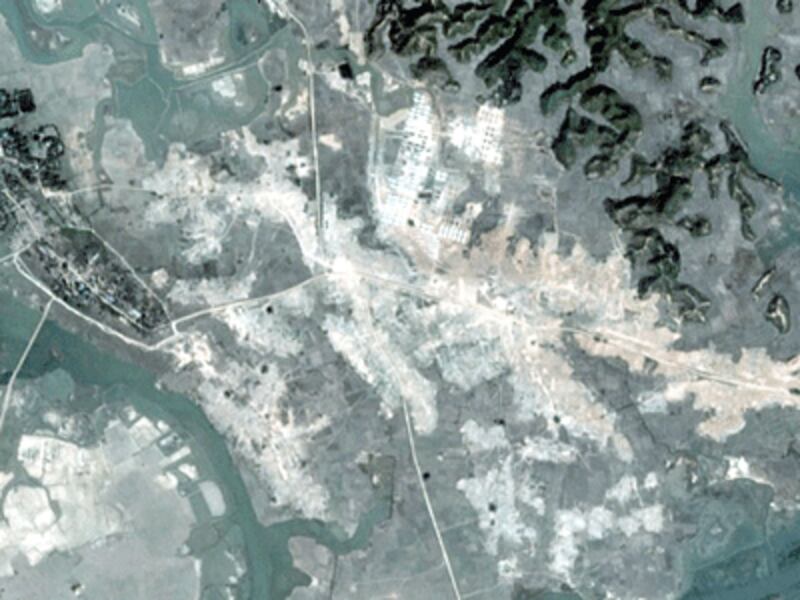An international rights group on Friday issued new satellite images showing the Myanmar government's demolition of dozens of deserted Rohingya Muslim villages in northern Rakhine state in recent months, charges that Myanmar officials insist was part of reconstruction work.
Human Rights Watch (HRW), citing the images, said the government used heavy machinery to clear all structures and vegetation in at least 55 villages, most of which were among 362 villages completely or partially destroyed by arson during a military crackdown on the persecuted group that began in late August.
The satellite images indicate that at least two of the demolished villages were previously undamaged by fire and likely inhabitable, while hundreds of structures have been torn down in 10 other villages partially destroyed by fire, HRW said.
The group said it could not independently verify if any of the destroyed villages were inhabited when the demolition began, though the imagery suggests that the demolitions are ongoing.
HRW called on the United Nations Security Council, U.N. agencies, and international donors to demand that the government stop destroying the villages “which should be treated as crime scenes” until a U.N.-appointed fact-finding commission is allowed into the region to conduct an investigation.
“Many of these villages were scenes of atrocities against Rohingya and should be preserved so that the experts appointed by the U.N. to document these abuses can properly evaluate the evidence to identify those responsible,” said Brad Adams, HRW’s Asia director, in a statement. “Bulldozing these areas threatens to erase both the memory and the legal claims of the Rohingya who lived there.”
Myanmar security forces began attacking Rohingya communities in northern Rakhine after a militant Muslim group called the Arakan Rohingya Salvation Army (ARSA) carried out deadly assaults on police outposts on Aug. 25.
The brutal campaign, which refugees and rights groups say included indiscriminate killings, rape, and arson, forced nearly 700,000 Rohingya to flee to neighboring Bangladesh in what the international community has said amounts to ethnic cleansing, if not genocide.
The Myanmar government has denied accusations of atrocities committed by the army and prevented a U.N. commission from entering the region to investigate reports of abuses and killings. Independent reporting or fact finding in the area by reporters or forensic experts has not been permitted.

Reconstruction efforts
The HRW report comes as Myanmar and Bangladesh are preparing to begin repatriating Rohingya refugees to northern Rakhine, where the government has said it has built houses in more than 20 villages to accommodate the returnees.
Win Myat Aye, Myanmar’s minister of social welfare minister, earlier told Agence France-Presse that the demolition was part of a plan to rebuild the villages to a higher standard than before.
On Friday, he told RFA’s Myanmar Service that the demolitions reported by HRW are part of the region's overall reconstruction plan for for returning refugees.
“For their resettlement, we have to work on a village plan to replace the [old structures] by clearing burned houses in order to build new ones,” he said. “The roads will also be widened, and we will install lampposts as well. We already announced that we will provide electricity for the entire Maungdaw [township] region by the end of 2018."
“With the refugees returning, we have to build houses, schools, religious buildings, markets, and government offices according to a township plan,” Win Myat Aye said. “Because we are implementing this plan according to [the United Nations Human Settlements Programme’s] guidelines, we need to clear the burned buildings. This is the process for both villages and township plans. What HRW said must refer to these clearings, but we must clear the areas to implement the plan.”
In accordance with an agreement with Bangladesh, Myanmar has already built two refugee processing facilities and a transit camp where returning Rohingya must stay for several days before they can be transferred to their previous places of residence, he said.
In response to HRW’s report, Maung Ohn, a Rakhine state lawmaker who represents Maungdaw township where new structures for returning refugees are being built, also said the demolitions are part of the project to build new houses for refugees.
“I’ve heard that authorities are working on the resettlement projects for the refugees who are returning homes,” he told RFA. “Because their villages were burned down, the authorities have to clear them to build new buildings for the people who are returning.”
Rights groups and the U.N. have warned against a hasty return of the refugees, saying that they will continue to face repression and discrimination in Buddhist-majority Myanmar, where they are considered illegal immigrants from Bangladesh and are denied citizenship and access to basic services.
“Conditions are not yet conducive to the voluntary repatriation of Rohingya refugees,” said Filippo Grandi, U.N. high commissioner for refugees, during a U.N. Security Council briefing on the situation in Myanmar on Feb. 13. “The causes of their flight have not been addressed, and we have yet to see substantive progress on addressing the exclusion and denial of rights that has deepened over the last decades, rooted in their lack of citizenship.”
EU prepares sanctions
Meanwhile, the European Union is preparing to impose sanctions on Myanmar army generals and diplomats over the crackdown on the Rohingya.
Ministers are expected on Monday to ask Federica Mogherini, the EU’s foreign policy chief, to put together a list of senior Myanmar military officials to sanction for their alleged involvement in human rights abuses, Reuters reported Thursday.
Though the EU has had an arms embargo on Myanmar since the 1990s, new sanctions in the form of visa bans and asset freezes would be the bloc’s toughest measures on the country to date, the report said.
The U.S. and Canada have already imposed sanctions on Myanmar military officers, including Major General Maung Maung Soe, head of the Myanmar Army’s Western Command, who led the military’s brutal crackdown on the Rohingya.
Reported by Thiri Min Zin for RFA’s Myanmar Service. Translated by Khet Mar. Written in English by Roseanne Gerin.
